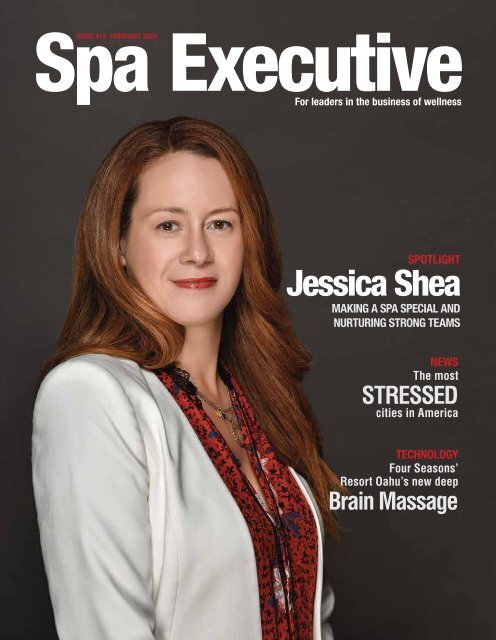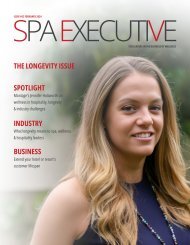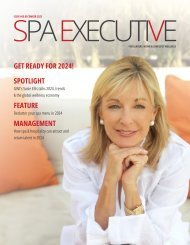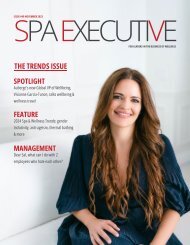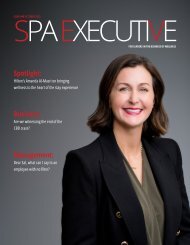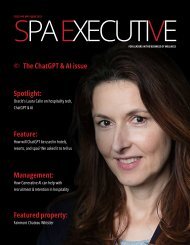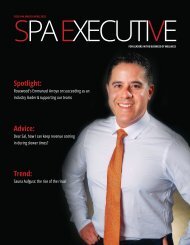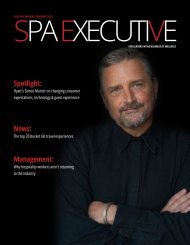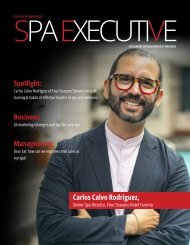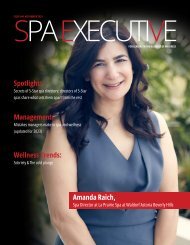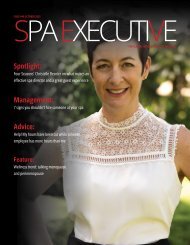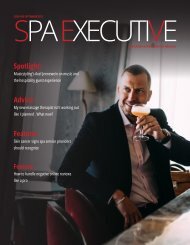Spa Executive - February 2020
You also want an ePaper? Increase the reach of your titles
YUMPU automatically turns print PDFs into web optimized ePapers that Google loves.
<strong>Spa</strong> <strong>Executive</strong><br />
ISSUE #15 FEBRUARY <strong>2020</strong><br />
For leaders in the business of wellness<br />
SPOTLIGHT<br />
Jessica Shea<br />
MAKING A SPA SPECIAL AND<br />
NURTURING STRONG TEAMS<br />
NEWS<br />
The most<br />
STRESSED<br />
cities in America<br />
TECHNOLOGY<br />
Four Seasons’<br />
Resort Oahu’s new deep<br />
Brain Massage
PUBLISHER<br />
Roger Sholanki<br />
CREATIVE DIRECTOR<br />
Nima Chadha<br />
EDITOR<br />
Elizabeth Bromstein<br />
COPY EDITOR<br />
Andrea Coreas<br />
DESIGNER<br />
Zamir Visram<br />
Note from the Publisher<br />
Hilton was recently named the #1 best place to work by Fortune magazine. In an industry that<br />
struggles to attract and retain staff, spa and wellness leaders should be paying close attention to<br />
what Hilton is doing right.<br />
It appears to be a lot — Hilton CEO, Chris Nassetta, has said that he is “obsessed” with taking<br />
care of his staff.<br />
Among Hilton’s initiatives is one to upgrade all back-of-house staff areas to be as comfortable<br />
and welcoming as guest areas. Hilton also offers programs enabling employees to earn their<br />
GEDs and expand their skillsets, including the Hilton School of Wellness <strong>Spa</strong> Leader Onboarding<br />
Program, which is designed to help Hilton spa professionals thrive as business leaders. Hilton is<br />
also an advisory board member of We Care, the global self care initiative for massage therapists<br />
and spa directors.<br />
Who better to talk about some of the amazing programs that are changing the face of hospitality<br />
leadership than Jessica Shea, Hilton’s Senior Director of <strong>Spa</strong> & Fitness Operations for the<br />
Americas? We spoke with her for this month’s Spotlight interview, and she offers some amazing<br />
insight into Hilton’s successes from which we can all learn.<br />
“Massage therapists,” she points out, “are the backbone of the spa industry…. Yet, as the spa<br />
industry grows, the number of massage therapists continues to decline.”<br />
Hilton is among those turning this around. Is it coincidence that Hilton’s stock is reportedly up<br />
274% from its IPO price in 2013? Probably not. Looking after your team is good for business.<br />
As far as obsessions go, taking care of your staff is a good one to have.<br />
<strong>Spa</strong> <strong>Executive</strong><br />
Roger Sholanki,<br />
CEO, Book4Time Inc.<br />
The online magazine for <strong>Spa</strong><br />
<strong>Executive</strong>s, featuring news<br />
and exclusive interviews.
Contents<br />
<strong>February</strong> <strong>2020</strong> Volume 15<br />
3<br />
TRENDS<br />
Next Generation Aromatherapy:<br />
how research & tech are<br />
changing the game<br />
3<br />
MANAGEMENT<br />
Behaviors of successful leaders<br />
5 in spa and wellness<br />
7<br />
NEWS<br />
The cities most in need of a spa<br />
day: these are the most<br />
stressed out people in America<br />
9<br />
BUSINESS<br />
The Wellness Tourism<br />
Association’s definitions for<br />
what makes a wellness tourism<br />
destination<br />
12<br />
TECHNOLOGY<br />
Four Seasons Resort Oahu at<br />
Ko Olina's new "Deep Brain<br />
Massage"<br />
15<br />
13<br />
FEATURED PROPERTY<br />
Ocean <strong>Spa</strong> BVI: a floating spa<br />
built from the wreckage of<br />
Hurricane Irma<br />
15<br />
SPOTLIGHT<br />
Hilton’s Jessica Shea on what<br />
makes a spa special and<br />
nurturing strong teams<br />
19<br />
FEATURE<br />
Scents to make people fall in<br />
love with your spa, with<br />
Matthew Mileo<br />
7 12
WELLNESS TREND <strong>2020</strong><br />
Next Generation Aromatherapy:<br />
How research & tech are changing the game<br />
Aromatherapy is hardly new. The practice<br />
of turning to scents and essential oils for<br />
their purported healing properties is<br />
probably thousands of years old, and<br />
though it’s often said that there is little<br />
solid scientific evidence for its efficacy,<br />
aromatherapy’s popularity continues<br />
to grow.<br />
As we mentioned in our recent trends<br />
report, the Global Wellness Institute<br />
recently named “Aromatherapy 2.0: Scent<br />
as Medicine” as a trend to watch, citing<br />
many examples of how aromatherapy is<br />
moving into a new era, thanks to<br />
technological advancement and<br />
neuroscience studies. Among the<br />
examples cited was Aeroscena, a<br />
company based in the Cleveland Clinic’s<br />
Innovations Lab that has created a line of<br />
plant-based aromatherapeutics formulated<br />
to specifically treat symptoms like pain,<br />
nausea, and anxiety, with the guidance of<br />
a medical advisory board.<br />
We wanted to further explore<br />
developments in aromatherapy, so we<br />
reached out Mark Kohoot, Aeroscena’s<br />
founder and CEO, to ask some questions<br />
about potential future research,<br />
applications, and developments.<br />
Standardized and evidence based<br />
Kohoot says next generation<br />
aromatherapy is rapidly moving toward a<br />
medical/clinical paradigm and an<br />
evidence-based practice.<br />
“This is why we differentiate what we do<br />
as ‘clinical aromatherapy,’” he says. “It is<br />
standardized, evidence-based, quality<br />
controlled and clinically validated.” The<br />
focus is on testing and outcomes, so<br />
Aeroscena has partnered with medical<br />
practitioners and facilities, like the Moffitt<br />
Cancer Center, Nebraska Children’s<br />
Hospital, and Virginia Commonwealth<br />
University, where clinical research can be<br />
performed by third parties without bias.<br />
The research landscape is changing<br />
dramatically<br />
A lack of credible research is often cited<br />
as a concern when it comes to<br />
aromatherapy, but things are shifting.<br />
Kohoot points out that a quick search in<br />
PubMed now results in 1,401 studies that<br />
include the term “aromatherapy.”<br />
“Historically,” he says, “aromatherapy has<br />
suffered from perception issues, and been<br />
lumped in with ‘alternative’ therapies,<br />
many of which are looked down upon by<br />
the medical community. Luckily, nurses —<br />
those on the front lines of patient care —<br />
have become amazing advocates and<br />
research partners.”<br />
One research example he points to is<br />
Nebraska Children’s Hospital’s palliative<br />
care department: “The medical director,<br />
Dr. Meaghann Weaver, was interested in<br />
finding out how aromatherapy could help<br />
her patients, and liked that our inhalers<br />
provided a standardized form factor for<br />
use. She noted improvements across the<br />
board after adoption, and asked us to<br />
work with her on a pilot study by providing<br />
materials. The positive results of the study<br />
on pediatric pain, anxiety, and nausea<br />
were then published by Cambridge<br />
University last November in the journal<br />
Palliative and Supportive Care.”<br />
Aeroscena also participated in research<br />
with Moffitt Cancer Center to examine the<br />
effect of aromatherapy on nausea and<br />
anxiety in patients undergoing<br />
chemotherapy at their infusion centers.<br />
“The results were positive here as well,”<br />
said Kohoot, with a 50%-80% reduction in<br />
nausea and anxiety achieved across all<br />
three centers. The reduction of both<br />
symptoms was maintained over the<br />
five-month course of treatment for the<br />
majority of study participants.<br />
“Acceptance of and demand for<br />
aromatherapy in clinical environments<br />
continues to grow at a remarkable pace.”<br />
How can aromatherapy be used in a<br />
wellness setting, like a spa, to create<br />
different results and outcomes?<br />
Kohoot uses the example of a larger, more<br />
complex spa setting with multiple<br />
environments.<br />
To create a relaxing atmosphere, the<br />
reception area can be scented with a<br />
formula based on constituent ingredients<br />
that have demonstrated anti-anxiety<br />
effects in clinical studies, he says.<br />
03 | <strong>Spa</strong> <strong>Executive</strong><br />
Trends
“Then, the spa client could go to more<br />
than one area from reception for any<br />
number of treatments. While many likely<br />
hope to relax, some may prefer to feel<br />
more energized or focused.”<br />
Aeroscena, he explains, creates formulas<br />
designed for these specific results using<br />
an efficacy-first model. “We first find the<br />
oils that have the best supporting scientific<br />
evidence for what we hope to achieve and<br />
then we take those oils to our master<br />
aromatherapist, who finds a combination<br />
and ratio of those oils that also produces a<br />
pleasant scent.”<br />
He goes on to say, “Many large spas also<br />
have gyms, pools, hydrotherapy circuits,<br />
luxurious locker rooms, and dedicated<br />
rooms reserved for yoga and the like.<br />
Whether spas want to uplift, energize, or<br />
relax clients, there is an all-natural, truly<br />
healthy option available to do just that.”<br />
How aromatherapy is being used in<br />
hospitals and other healthcare settings<br />
There are many areas of healthcare where<br />
aromatherapy is appropriate, says Kohoot,<br />
who cites chemotherapy infusion centers,<br />
dialysis centers, postoperative recovery<br />
rooms, birthing centers, and palliative<br />
care, among the examples.<br />
“It’s also very useful in waiting rooms to<br />
decrease patient anxiety prior to treatment<br />
or consultation. This is especially true for<br />
dental offices, where malodors are<br />
common and patient dental anxiety is a<br />
real problem for practitioners, who then<br />
struggle with patient recall. A more<br />
pleasant, relaxing waiting room experience<br />
can create a positive feedback cycle that<br />
means less dental fear, and more returning<br />
patients who get the care they need.”<br />
Developments involving aromatherapy<br />
and technologies, like AI and VR<br />
Aeroscena is involved in some aspects of<br />
VR and AR, but “not what you’d think,”<br />
said Kohoot. They’re working with Johns<br />
Hopkins and Drexel University on the issue<br />
of nausea in children getting VR rehab.<br />
“The feeling of disembodiment that comes<br />
with floating in space often is<br />
accompanied by nausea and nobody likes<br />
cleaning that up.”<br />
And, by now we’ve all read about the idea<br />
of enhancing movies and virtual worlds<br />
with scent.<br />
Kohoot said, “Our best guess is that the<br />
gaming industry will work to use the smell<br />
of tires/gas/oil for racing games or<br />
something like that. However scents are so<br />
complex, it is hard to have a set of a few<br />
chemicals that can be mixed, like a cmyk<br />
printer, to make most scents. And, really,<br />
that sort of thing is going to be synthetic<br />
fragrances, more than aromatherapy.”<br />
How aromatherapy will be used five or 10<br />
years from now<br />
“Aromatherapy has plenty of potential in<br />
terms of new applications and<br />
environments, especially when used in<br />
concert with technologies like AI and VR,”<br />
said Kohoot, “But one of the main changes<br />
we expect to see is the acceptance of<br />
aromatherapy as a drug, rather than an<br />
‘alternative therapy.’”<br />
He envisions successful research leading<br />
to more interest in standardized solutions<br />
for aromatherapy as an over the counter,<br />
and even prescription, drug to treat<br />
specific medical conditions.<br />
“We also expect to see more research into<br />
essential oils as antiviral and<br />
antibacterial agents.”<br />
Trends<br />
<strong>Spa</strong> <strong>Executive</strong> | 04
Behaviors of<br />
successful leaders in<br />
spa and wellness<br />
These five behaviors of successful leaders in spa<br />
and wellness will make or break a business.<br />
It’s fairly well known that successful<br />
leaders, regardless of industry, tend to<br />
display common behaviors.<br />
The best leaders are good listeners and<br />
communicators and they have the self<br />
awareness to monitor their responses and<br />
reactions. They think before they speak<br />
and they work to elevate their employees,<br />
rather than keep them down, because<br />
they know that’s what makes a business<br />
thrive. Let’s take a look at some of these<br />
specific behaviors and how they apply in<br />
spa and wellness. These are the habits<br />
and actions that will make or break<br />
a business.<br />
We often have the pleasure of speaking<br />
with some of the top leaders in this sector,<br />
so we took an opportunity to look back at<br />
some of their past comments about the<br />
things that make successful leaders.<br />
Here are five behaviors of successful<br />
leaders in spa and wellness:<br />
Listening<br />
All good leaders are good listeners. Great<br />
spa and wellness leaders listen to their<br />
team members and respond to needs and<br />
wants. They listen to their guests and do<br />
the same to improve the guest<br />
experience. They listen to hear about<br />
what’s happening in the sector, with<br />
trends, news and developments, to stay<br />
on top of these things.<br />
Todd Hewitt, Assistant Vice President,<br />
<strong>Spa</strong>, at Shangri La told us in his Spotlight<br />
interview “When you listen to the guests<br />
and staff firsthand, you get a totally<br />
different perspective of the operation.”<br />
If you don’t listen, you can’t learn, and if<br />
you can’t learn you can’t grow, and if you<br />
can’t grow you can’t manage.<br />
05 | <strong>Spa</strong> <strong>Executive</strong> Management
Learning<br />
Great leaders are lifelong learners. The<br />
world is always going to change and we<br />
have to keep up, and spa and wellness is<br />
an ever changing and growing industry.<br />
Developments in science, technology, and<br />
tourism mean that things are always<br />
shifting, and change can be daunting and<br />
terrifying for those who are not always<br />
learning. But for those with a lifelong<br />
passion for learning, change is<br />
exhilarating. Challenges become puzzles<br />
to be solved and hurdles to overcome.<br />
Education comes from many sources and<br />
in many forms. It’s not just acquired<br />
through books and courses. We learn from<br />
our peers and mentors, and from our<br />
employees. Hewitt also told us, “You have<br />
to want to learn something new each day<br />
and be willing to have your staff teach you<br />
something new too.”<br />
Thinking creatively<br />
Creativity is an important key to success in<br />
spa and wellness. There are a lot of spas<br />
out there, so why should someone choose<br />
yours over another? Thinking creatively<br />
will help you stand out from the<br />
competition and elevate your guest<br />
experience – to create something special.<br />
Jeremy McCarthy, Group Director of <strong>Spa</strong><br />
& Wellness at Mandarin Oriental<br />
Hotel, told us in his Spotlight interview<br />
that, early in his career, he met Peter<br />
Greenberg, a Travel Correspondent for<br />
Good Morning America at the time.<br />
McCarthy said, “I asked him how I could<br />
get my spa on television. ‘Getting your spa<br />
on TV is simple,’ he said. ‘All you have to<br />
do is do something no one else is doing or<br />
do something better than everyone else<br />
is doing.’<br />
“I quickly realized that even though I was<br />
working at a very nice luxury spa, we were<br />
really doing all the same stuff that<br />
everyone else was doing. For the rest of<br />
my career, I have always taken that advice<br />
to heart and tried to do things better or<br />
differently than everyone else.”<br />
Standing out requires creativity, and<br />
success in spa and wellness requires that<br />
you stand out.<br />
Leading by example<br />
A few times in the past, we have quoted<br />
Shane Bird, Director of <strong>Spa</strong> Operations at<br />
Turning Stone Resort and Casino, in his<br />
Spotlight interview, saying that the key to<br />
managing a successful team is “being<br />
willing as a manager or director to do<br />
everything, and to really get in the<br />
trenches.” Bird said a manager cannot<br />
stay in an office. “Your team has to see<br />
you engaging the guests in the way you<br />
want the guests engaged.”<br />
He added, “It’s being a part of the<br />
everyday operations as much as you<br />
possibly can. I’ve always been very hands<br />
on. At times, I’ve actually been chided by<br />
my superiors that I’m a little too hands on.”<br />
We quote this one a lot because it’s so<br />
important.<br />
Leading by example is behaving in the way<br />
that you expect your team members to<br />
behave. People don’t respect a leader who<br />
wants them to give something that they,<br />
themselves are not willing to give.<br />
Empowering others<br />
Great leaders empower their team members<br />
to make decisions and grant them the<br />
autonomy they need to do their jobs well.<br />
Andrew Gibson, Chairman of the Wellness<br />
Tourism Association, told us in his recent<br />
Spotlight interview, “I’ve seen, and worked<br />
for, many different types of successful<br />
leaders. One thing they all have in common<br />
is the ability to motivate. You have to be<br />
able to motivate people.<br />
“But perhaps the most difficult part of<br />
being a leader is learning to let go. You<br />
appoint people, give them a clear vision<br />
and achievable goals and support them<br />
towards those goals. Every member of the<br />
team should have goals or clear<br />
objectives. And then you have to trust<br />
them and let them lead. And you have to<br />
accept when doing that, that they will do<br />
things differently from you, and even make<br />
mistakes. If you want to build a great team<br />
that is successful and enjoys what they’re<br />
doing, you have to accept that some<br />
things are not going to go quite the way<br />
you want or expect them to go.”<br />
Empowering others mean relinquishing<br />
some of your control, and allowing people<br />
to do what they will do without interfering.<br />
We can all do our best to embody these<br />
five behaviors of successful leaders.<br />
Management<br />
<strong>Spa</strong> <strong>Executive</strong> | 06
THE CITIES MOST IN NEED OF A SPA DAY<br />
THESE ARE THE MOST STRESSED<br />
OUT PEOPLE IN AMERICA<br />
07 | <strong>Spa</strong> <strong>Executive</strong> News
These are the most<br />
stressed out cities in<br />
America. <strong>Spa</strong> day,<br />
anyone?<br />
Who are the most stressed-out people in<br />
America, where do they live and what<br />
stresses them out the most? A new<br />
survey asked these questions and found<br />
some answers, which we at <strong>Spa</strong> <strong>Executive</strong><br />
think could prove quite valuable to the<br />
<strong>Spa</strong> and Wellness industry.<br />
Knowing what stressors are affecting<br />
local populations can help wellness<br />
businesses connect with people and offer<br />
exactly what they need to relieve that<br />
stress. So, let’s take a look at the findings.<br />
Attorney directory, Just Great Lawyers (a<br />
surprising source for this information, we<br />
thought), conducted the survey, which<br />
sought to learn who the most stressed out<br />
people are in America. To do this, rather<br />
than try to estimate people’s stress levels<br />
based on factors like unemployment<br />
rates, commute times, or home prices,<br />
they took another tactic and just asked<br />
people about their stress levels. The<br />
report argues that, “when it comes to<br />
stress, perception can be more important<br />
than reality,” and, that “the human<br />
nervous system is designed to respond to<br />
threats real or imagined, evoking the<br />
same physical and emotional<br />
consequences either way. So in essence,<br />
how stressed people think they are is<br />
exactly how stressed they really are.” This<br />
sounds reasonable.<br />
Just over 2,700 people in 25 major<br />
American cities were asked to rate their<br />
stress levels around a variety of factors.<br />
The results showed that Americans in<br />
general are currently feeling more<br />
stressed than they were a year ago with<br />
sources varying from city to city.<br />
The most stressed out cities<br />
The most stressed out city was<br />
Indianapolis, IN, followed by Houston, TX,<br />
and Washington, D.C. Indianapolis also<br />
ranked in the top five for stress levels<br />
about money and political concerns.<br />
Interestingly, eight of the most stressed<br />
out cities are located east of the<br />
Mississippi, while the two least stressed<br />
cities are in the South and Southwest.<br />
The most stressed out professions<br />
Human resources, architecture, and<br />
religious ministry are the most stressed<br />
out professions, followed by those in pet<br />
care, and attorneys and others in the legal<br />
profession to round out the top five.<br />
The report makes the observation that<br />
practitioners of these professions “hold<br />
people’s (or animals’) lives in their hands”<br />
in one way or another. “HR decisions<br />
make or break the quality of life for<br />
millions of people. An architect’s<br />
creations must be perfectly planned and<br />
constructed, or buildings come crashing<br />
own. Religious counselors work for<br />
nothing less than the integrity of people’s<br />
souls. And vet workers care for the lives of<br />
our precious pets — which, in America,<br />
might as well be people.“ It’s interesting,<br />
then, that doctors aren’t in the top five.<br />
At the other end of the spectrum, fitness<br />
professionals, real estate agents, and<br />
government workers are feeling the least<br />
stressed. Somewhere in the middle are<br />
hospitality and service industry workers,<br />
followed by educators and career military<br />
members.<br />
Being unable to work because of a<br />
disability was about as stressful as<br />
working in HR or architecture. Being out<br />
of work and running a business were both<br />
equally stressful, and retirees were the<br />
least stressed out of anyone.<br />
Other significant findings of the<br />
survey include:<br />
• Young people feel more stress than<br />
older people.<br />
• Women feel more stress than men.<br />
• People with lower incomes generally<br />
feel more stress than people with<br />
higher incomes.<br />
• Stress levels decreased as income<br />
increased over $15,000 a year, but<br />
began creeping back up gain when<br />
income reached $250,000.<br />
• Las Vegas, NV, Indianapolis, IN, and<br />
Houston TX, residents report feeling<br />
the most financial stress.<br />
• People in Phoenix, AZ, Cleveland,<br />
OH, and New York, NY, feel the least<br />
financial stress.<br />
• San Francisco Bay area, CA,<br />
residents feel the most career stress.<br />
• Atlanta, GA, residents are a lot less<br />
worried about their careers.<br />
• Residents of Washington, D.C., are<br />
most stressed about health and<br />
healthcare, family matters, political<br />
concerns, and personal safety.<br />
• Houston, TX, San Francisco, CA, and<br />
Las Vegas, NV, residents are also<br />
stressed about health and healthcare.<br />
• New Orleans residents are least<br />
worried about their health.<br />
• When it comes to marketing spa<br />
services, these findings may help<br />
directors and operators come up with<br />
creative outreach ideas to connect<br />
with, for example, young, female HR<br />
professionals in Indianapolis or<br />
Washington D.C.<br />
See the full report at<br />
justgreatlawyers.com/most-stressed-cities<br />
News<br />
<strong>Spa</strong> <strong>Executive</strong> | 08
The Wellness Tourism Association’s definitions<br />
for what makes a wellness tourism destination<br />
The Wellness Tourism Association (WTA) has<br />
introduced definitions and begun setting industry<br />
standards for what makes a wellness tourism<br />
destination.<br />
By Anne Dimon<br />
We all acknowledge that the word<br />
“wellness” means different things to<br />
different people. Ask 10 people what<br />
“wellness” means to them and you are<br />
likely to get 10 different answers.<br />
Year after year, surveys from the Global<br />
Wellness Institute tell us wellness is the<br />
fastest growing division of the global<br />
tourism industry. As more consumers look<br />
to work elements of wellness into their<br />
travels, or plan vacation time with a<br />
specific focus on wellness, we are seeing<br />
an increasing number of hotels and<br />
resorts looking to get a share of the<br />
market by introducing wellness-focused<br />
amenities, programs and even multi-day<br />
guided retreats. Destination Management<br />
Organizations (DMO) and tourism boards<br />
are also launching their own wellness<br />
initiatives. But for the good of the<br />
consumer and the sustainable future of<br />
the industry, when it comes to vocabulary<br />
we need clarity and consistence.<br />
To help create that clarity and consistency<br />
within the wellness tourism industry, the<br />
Wellness Tourism Association (WTA) –<br />
now with 100 Members and Partners from<br />
21 countries – has created definitions,<br />
and promotes standards that are<br />
applicable to the industry and understood<br />
by the public.<br />
Incorporated in the US as a not-for-profit<br />
in January of 2018, the Wellness Tourism<br />
Association launched with the mission to<br />
unite the industry, and to become one<br />
community working together to shape and<br />
09 | <strong>Spa</strong> <strong>Executive</strong> Business
support the sustainable future of wellness<br />
tourism for the global good. One of the<br />
goals was to bring definitions and<br />
standards to the industry.<br />
First of all, the WTA has produced the first<br />
glossary of industry definitions.<br />
Glossary of industry definitions<br />
Wellness Tourism<br />
A specific division of the global tourism<br />
industry that is defined by the common<br />
goal of marketing natural assets and<br />
activities primarily focused on serving the<br />
wellness-minded consumer.<br />
Wellness Travel<br />
Travel that allows the traveler to maintain,<br />
enhance or kick-start a healthy lifestyle,<br />
and support or increase one’s sense of<br />
wellbeing.<br />
Wellness Traveler<br />
An individual who makes “wellness” the<br />
primary purpose of a trip.<br />
Wellness Vacation/Holiday<br />
Wellness Vacation / Holiday is Wellness<br />
Travel powered by a wellness-focused<br />
intention. Wellness Vacations/Holidays are<br />
typically self-directed with the traveler<br />
setting his or her own timetable and<br />
schedule. They may also include a<br />
Wellness Retreat.<br />
Wellness Retreat – In today’s world, this<br />
term actually has two definitions:<br />
Wellness Retreat – Programme<br />
#1 A guided, intention-driven, multi-day<br />
program with a set or semi-set schedule,<br />
and hosted by one or more facilitators. The<br />
program may include learning and lifestyle<br />
workshops such as meditation and healthy<br />
eating, as well as fitness activities such as<br />
yoga, nature walks and hiking.<br />
Wellness Retreat – Facility<br />
#2 A smaller facility with accommodations<br />
and hospitality services and where the<br />
primary purpose is to provide programs<br />
and experience for the Wellness Traveler.<br />
The facility may have fewer wellness<br />
activities, services and facilities than a<br />
Wellness Resort.<br />
Industry standards<br />
When it comes to developing standards,<br />
our criteria for the various categories of<br />
membership forms the basis for industry<br />
standards. For instance:<br />
Wellness Resort<br />
Any facility with accommodations and a<br />
range of hospitality services where the<br />
primary purpose is to provide programs<br />
and experiences for the Wellness Traveler.<br />
The Wellness Resort is comprised of four<br />
primary elements: accommodations, a<br />
variety of wellness activities, healthy<br />
dining options and wellness-related<br />
facilities.<br />
Wellness Retreat<br />
(facility standard as per above)<br />
Any smaller facility with accommodations<br />
plus other hospitality related amenities,<br />
and where the primary purpose is<br />
wellness. Such companies offering<br />
qualifying wellness programs on a<br />
seasonal basis will also fall under the<br />
category of Wellness Retreat.<br />
Medical Wellness<br />
A company with the primary business of<br />
medical (the care of patients, and services<br />
that respond to specific medical<br />
conditions or issues) will be considered for<br />
membership if they also offer multi-day<br />
retreats / programs and/or packages that<br />
are deemed to be more<br />
proactive/preventative than reactive. For<br />
instance, retreats/programs for sleep,<br />
stress management, medical testing for<br />
the early detection and prevention or<br />
certain medical conditions, and others.<br />
Assets and attributes of a Wellness<br />
Destination<br />
In July, 2019, the WTA issued a news<br />
release suggesting nine assets and<br />
attributes that a geographic destination<br />
should possess if the DMO or tourism<br />
board is looking to position and promote a<br />
specific region of the world as a Wellness<br />
Destination.<br />
The list of nine is as follows:<br />
• A safe/secure environment in both<br />
perception and reality<br />
• A clean and sanitary infrastructure for<br />
both locals and visitors<br />
• A quality-of-life for locals who benefit<br />
from tourism dollars – e.g. the creation<br />
of jobs within the industry and the<br />
creation of a market for locally made<br />
produce/products/services<br />
• Natural assets such as hot<br />
springs/mountains/bodies of<br />
water/forests/resources for<br />
thalassotherapy or other natural<br />
assets within the confines of the<br />
destination and easily accessible to<br />
visitors<br />
• Since Wellness Tourism and Wellness<br />
Travel encompass wellness for the<br />
planet, the destination must have<br />
substantial sustainability policies and<br />
practices in place<br />
• The availability and accessibility of a<br />
wide range of wellness-professionals<br />
and practitioners, including those who<br />
offer holistic and alternative modalities<br />
Business<br />
<strong>Spa</strong> <strong>Executive</strong> | 10
• A selection of hotel restaurants and<br />
independent restaurants offering<br />
healthful cuisine prepared by chefs<br />
committed to clean eating and who<br />
work in partnership with local growers<br />
• Availability of a range of fitness-based<br />
activities and tours – e.g. yoga, hiking,<br />
cycling, fitness classes, kayaking,<br />
stand-up paddle boarding<br />
• A physical environment that is<br />
somewhat removed from the noise<br />
that has become “daily life” in the 21st<br />
century<br />
WTA Chairman, Andrew Gibson, says<br />
“Wellness Tourism has the fastest visitor<br />
year on year growth of any form of<br />
tourism. The Wellness Tourism Association<br />
provides clarity and direction for anyone<br />
who wants to identify with this exciting<br />
sector within the tourism industry. There is<br />
a great opportunity to ensure that wellness<br />
tourism is sustainable, ethical and adds<br />
value to both the traveler and the<br />
destination.”<br />
Anne Dimon is the President of the<br />
Wellness Tourism Association<br />
(www.wellnesstourismassociation.org) and<br />
Founder/Editor of<br />
www.traveltowellness.com<br />
11 | <strong>Spa</strong> <strong>Executive</strong> Technology Business
FOUR SEASONS RESORT OAHU AT KO<br />
OLINA'S NEW "DEEP BRAIN MASSAGE"<br />
Four Seasons Resort Oahu at Ko Olina<br />
has partnered with immersive wellness<br />
company, Sensync, to offer “a<br />
revolutionary, immersive sensory<br />
experience” called The Vessel.<br />
Luxury virtual experience<br />
The Vessel is a luxury virtual experience<br />
that combines mixed reality with<br />
advanced therapeutic technology to<br />
create what Sensync’s founders, Dr.<br />
Adam Gazzaley and Dr. Alex Theory, have<br />
dubbed a “Deep Brain Massage.”<br />
Gazzaley is The David Dolby<br />
Distinguished Professor of Neurology,<br />
Physiology and Psychiatry at the UC San<br />
Francisco, and the Founder and <strong>Executive</strong><br />
Director of Neuroscape, a translational<br />
neuroscience centre engaged in<br />
technology development and scientific<br />
research of novel brain assessments and<br />
optimization tools. And Theory is a CEO<br />
and Futurist specialising in large scale<br />
immersive experiences, interactive<br />
content, augmented reality, virtual reality,<br />
and transmedia storytelling.<br />
The treatment involves a series of<br />
customized journeys in which guests see,<br />
hear, smell, feel, and touch sensations of<br />
nature, presented in unison, leveraging<br />
the power of what Sensync calls “sensory<br />
synchronization” to create immersive<br />
experiences. Recordings of the guest’s<br />
physiological data — respiration, heart<br />
rate, electrodermal activity and<br />
electroencephalography — allow the<br />
generation of a dynamic, closed-loop<br />
experience that is personalized in<br />
real time.<br />
Among the immersive journeys being<br />
offered are Deep <strong>Spa</strong>ce, Kairos, Ocean<br />
Cove, Zen Garden, Quantum Oneness,<br />
Crystal Cave, Lost Jungle, and Floating<br />
Clouds. These range from 20 to 80<br />
minutes in duration, integrating:<br />
• Visual virtual reality treatments<br />
• Aromatherapy<br />
• Sound and music therapy<br />
• Vibroacoustic stimulation<br />
• Relaxation and nature therapy,<br />
meditation/mindfulness practices,<br />
biofeedback, and neurofeedback<br />
Research shows brain health benefits of<br />
nature exposure<br />
Sensync and Four Seasons point to the<br />
many research findings connecting brain<br />
health benefits with nature exposure.<br />
These benefits are said to include stress<br />
reduction, improved attention, and mood<br />
enhancement.<br />
The Vessel, says the release, creates “the<br />
next level of virtual reality,” and takes<br />
travellers “on a journey with a greater<br />
sense of presence and immersion than<br />
has ever been achieved.”<br />
The Vessel is an experiential treatment<br />
designed to address a demand for<br />
solutions and new technology that can<br />
facilitate wellness in the face of increases<br />
in stress, fatigue, anxiety, depression,<br />
insomnia, and other mental health issues.<br />
This is according to a media release,<br />
which also states that The Vessel’s<br />
purpose is to relax and restore fatigued<br />
minds and pull users away from<br />
“goal-directed thoughts,” with an aim to<br />
ease cognitive fatigue.<br />
Technology<br />
<strong>Spa</strong> <strong>Executive</strong> | 12
A look inside Ocean <strong>Spa</strong> BVI<br />
a floating spa built from the<br />
wreckage of Hurricane Irma<br />
Ocean <strong>Spa</strong> BVI is a floating spa, anchored<br />
off the coast of the island of Jost Van<br />
Dyke in White Bay, in the British Virgin<br />
Islands. Rocking gently on the serene,<br />
salty waters, it is the only floating spa in<br />
the BVI and one of the only floating spas<br />
in all of the Caribbean.<br />
The 550 square-foot structure was<br />
created by Dale Mapp, a 25-year veteran<br />
of the hospitality industry. It took 10 years<br />
for Mapp to realize his dream of opening a<br />
spa, and Ocean <strong>Spa</strong> BVI is his third try.<br />
The first attempt was vandalized, and the<br />
second was destroyed by Hurricane Irma,<br />
which swept through the open Atlantic<br />
region in September, 2017.<br />
The most powerful hurricane on record in<br />
the area at the time, Irma caused<br />
catastrophic damage and killed more than<br />
130 people. The British Virgin Islands<br />
were hit hard. The island of Tortola bore<br />
the brunt of the core, suffering damage to<br />
structures and seeing residential areas<br />
left in ruins. And almost all of the homes<br />
and businesses on Jost Van Dyke, the<br />
smallest of the BVI’s four main islands,<br />
were destroyed. The restoration of<br />
electricity alone took five months.<br />
“I had no choice<br />
but to rebuild”<br />
“After the hurricane struck, I felt I had no<br />
choice but to rebuild and not give up, so I<br />
continued,” Mapp told <strong>Spa</strong> <strong>Executive</strong>. He<br />
rebuilt the spa, this time with lumber<br />
salvaged from Irma’s wreckage, sourcing<br />
materials from the dump — “wooden<br />
gates, storage boxes, closet doors, and<br />
bits of people’s roofs.” He and one other<br />
person built the spa over four months,<br />
and it now sits on the water on a pontoon,<br />
supported by aluminum, and boasting a<br />
five-star rating on TripAdvisor.<br />
Windows beneath the massage tables<br />
allow guests to gaze into the water<br />
below<br />
13 | <strong>Spa</strong> <strong>Executive</strong> Featured Property
Access to the spa is by water. Mapp provides a<br />
complimentary dinghy taxi to and from, but more<br />
adventurous guests choose to boat, paddle board, kayak, or<br />
swim their way there. There are four treatment rooms, where<br />
guests can enjoy spa treatments and, as Mapp told <strong>Spa</strong><br />
<strong>Executive</strong>, “the feeling of floating on the Ocean with the<br />
gentle sway, reminiscent of being rocked in a cradle while<br />
inhaling the most revitalizing sea air.” Rectangular windows<br />
under the massage tables, inspired by glass bottomed<br />
boats, allow people to gaze into the water and watch the<br />
colorful fish swimming around below.<br />
“A dolphin even swam under once while I was giving a<br />
massage,” said Mapp.<br />
Ocean <strong>Spa</strong> BVI offers a simple menu, consisting of seven<br />
massage options, provided by Mapp and one other<br />
employee. These include a 75-minute Sunset Couples<br />
Massage with two glasses of sparkling wine, a 60-minute<br />
Ocean Bliss Aromatherapy Massage, and a 30-minute Ocean<br />
Head Massage.<br />
Mapp said of his finally realized dream, “It feels as if it has a<br />
soul. Pieces of BVI homes and lives created this memorable<br />
and unique floating spa.”
HILTON’S<br />
WHAT MAKES A SPA SPE<br />
NUTURING SMA
CIAL AND<br />
LL TEAMS<br />
Hilton is a leading global hospitality<br />
company with a portfolio of 17<br />
world-class brands, including Waldorf<br />
Astoria and Conrad, operating in 113<br />
countries.<br />
Among those dedicated to fulfilling the<br />
brand’s mission to be the world’s most<br />
hospitable company, is Jessica Shea,<br />
Hilton’s Senior Director of <strong>Spa</strong> & Fitness<br />
Operations for the Americas, who directly<br />
oversees the company’s 35 spas in the<br />
region.<br />
As a leader in a company that was<br />
recently named the #1 Best Company to<br />
Work for by Fortune Magazine, Ms. Shea<br />
is well placed to provide insight on<br />
nurturing strong teams. We asked her<br />
about that, as well as about what is<br />
challenging and what is exciting in the spa<br />
& wellness industry for <strong>2020</strong>.<br />
Tell us about your career and how you<br />
came to be doing what you are today?<br />
My family owned a hair salon when I was<br />
growing up, and I was enlisted at a young<br />
age to help answer phones and sweep up<br />
hair! I went off to college, traveled a bit,<br />
and came back home to look for a job.<br />
During that time, my family was<br />
transitioning their hair salon into a day<br />
spa, and again needed help. Helping out<br />
grew and grew, until I was eventually<br />
managing the business myself – and<br />
realized I was already on the path that I<br />
had been searching for. What I wanted<br />
was to make a difference – to help people,<br />
to be creative and inspire (what we know<br />
of now as) personal wellness. I saw<br />
firsthand how self-care, relaxation,<br />
connection and feeling beautiful would<br />
turn around someone’s bad day – leaving<br />
them renewed and hopefully, being kinder<br />
to others when they stepped outside the<br />
spa. It always felt like a small way to help<br />
make the world a better place.<br />
From there, I spent the next several years<br />
as a <strong>Spa</strong> Director with Hyatt Hotels in<br />
Lake Tahoe, Kauai, and eventually<br />
Thailand. I had the incredible opportunity<br />
to lead spa and hotel teams in Asia for six<br />
years before returning to the US to head<br />
up spa strategy for Hilton. I’ve been in my<br />
current position, supporting spa<br />
operations, for the past two years.<br />
Hilton is an advisory board member of<br />
We Care, the global self care initiative for<br />
massage therapists and spa directors.<br />
Can you talk about why this is<br />
important?<br />
It’s important for several reasons, all<br />
stemming from the fact that massage<br />
therapists are the backbone of the spa<br />
industry. The majority of treatments<br />
provided in leading spas are based on<br />
massage, and one of the greatest<br />
opportunities for connection is between a<br />
massage therapist and a guest. Yet, as<br />
the spa industry grows, the number of<br />
massage therapists continues to decline.<br />
As industry leaders, we need to support<br />
the massage therapy profession by<br />
ensuring therapists have the tools,<br />
education and opportunities they need to<br />
have long, healthy, successful careers.<br />
Massage therapists are the ultimate<br />
caregivers, yet they often don’t take the<br />
time to care for themselves. We Care aims<br />
to change that through techniques,<br />
education and experiences that support<br />
their physical, mental and spiritual health.<br />
The purpose is to ensure that therapists<br />
currently working in spas continue to<br />
thrive, and to attract potential spa<br />
therapists to a meaningful, lucrative<br />
career.<br />
Spotlight<br />
<strong>Spa</strong> <strong>Executive</strong> | 16
Can you tell me a bit about the Hilton<br />
School of Wellness <strong>Spa</strong> Leader<br />
Onboarding Program?<br />
Absolutely – I’m very proud of the work<br />
we did on the program. The purpose of<br />
the program is to encourage emerging<br />
and current spa managers and directors<br />
to grow as business leaders by giving<br />
them the tools to develop beyond their<br />
current roles and help achieve their<br />
professional goals. It is designed to help<br />
Hilton spa professionals become more<br />
commercially focused and thrive as<br />
business leaders, through an eight-hour<br />
online crash course that includes<br />
everything from learning how to balance a<br />
budget, develop marketing strategies,<br />
oversee operations and manage teams.<br />
The course was also designed to propel,<br />
retain and attract new professionals in the<br />
spa industry, showcasing how diverse and<br />
instrumental the role of a <strong>Spa</strong> Director is<br />
in the dynamic world of wellness.<br />
Are these in place to address the<br />
industry staffing issue and can you talk a<br />
bit about this challenge? Is the industry<br />
doing enough to address it?<br />
Yes, as mentioned both of these<br />
programs are designed to address the<br />
staffing issues facing the industry, both<br />
for therapists and leaders. I think the<br />
numbers that some of the industry<br />
organizations have brought to light in the<br />
last few years – the huge amount of spa<br />
position vacancies, closures of massage<br />
schools, etc – have been a wake up call<br />
for the industry and it’s encouraging to<br />
see companies springing into action. We<br />
can always do more, but the goals are<br />
being set and there is focus and<br />
collaboration across many levels of the<br />
industry that I believe will start to turn the<br />
tide in the coming years.<br />
What is the biggest challenge facing spa,<br />
fitness and wellness in <strong>2020</strong>, besides<br />
staffing?<br />
As you mention, staffing is the biggest<br />
challenge – not just the number of people,<br />
but we must also emphasize the<br />
importance of employing people who are<br />
passionate, service-minded and can<br />
deliver on the growing expectations of the<br />
wellness customer.<br />
We are very fortunate that we have finally<br />
come to an era when wellness is totally<br />
mainstream. People have so many<br />
choices today on how to integrate<br />
wellness into their lives; but the wellness<br />
landscape is blurry and increasingly<br />
competitive. To remain relevant,<br />
successful business must step away from<br />
the buzzy wellness noise and define who<br />
they are, be consistent with what they can<br />
deliver and do it with passion and<br />
integrity.<br />
Do you think being a successful leader in<br />
spa and wellness requires different skills<br />
from leadership in other areas? If so,<br />
what are these?<br />
Absolutely. <strong>Spa</strong> leaders must have a great<br />
balance of “head” and “heart” skills. The<br />
spa environment can be very personal –<br />
sensitive, emotional, spiritual – yet it has<br />
to be approached with clear-headed<br />
business savvy. Successfully leading a<br />
team of intuitive care-givers one minute<br />
and presenting a budget to an ownership<br />
group the next, takes a special set of<br />
leadership skills. The most successful spa<br />
leaders know, or have learned, how to<br />
balance and support both with a lot of<br />
passion.<br />
How do Hilton spas stand out? What<br />
makes them unique or special?<br />
Hilton is one of the largest spa operators<br />
in the world and a combination of reach,<br />
culture, and opportunity attracts the best<br />
spa team members in the world. We have<br />
built the global Hilton <strong>Spa</strong> family to deliver<br />
the highest level of guest experiences<br />
across all of our brands, while ensuring<br />
each spa location is individual and<br />
embraces the environment that it is in. We<br />
are continually innovating the spa<br />
experience with new design perspectives,<br />
exceptional treatment and service<br />
offerings, product partnerships, and<br />
sustainability initiatives.<br />
What trends or developments in spa and<br />
fitness are you excited about right now?<br />
I’m excited that in looking ahead, we are<br />
really taking a look back and evolving<br />
ancient, tried and true, natural or<br />
culturally significant wellness practices.<br />
The rise of hydrotherapy and contrast<br />
bathing dates back to Roman times; CBD<br />
has been revered in some cultures for<br />
centuries; shamans and gurus are leading<br />
more and more spiritual retreats (some<br />
with long-overlooked psychotropic<br />
benefit); skin care is clean and organic<br />
beauty has stripped back the<br />
unnecessary, toxic elements; fitness<br />
technology is focused on being in-tune<br />
with your biology; well-built spaces are<br />
concerned with clean air and sunlight;<br />
women’s health and sexuality aren’t<br />
taboo; and everyone is talking about the<br />
benefits of getting outside in nature!<br />
17 | <strong>Spa</strong> <strong>Executive</strong><br />
Spotlight
<strong>Spa</strong> <strong>Executive</strong><br />
FOR LEADERS IN THE BUSINESS OF WELLNESS<br />
ADVERTISE WITH US<br />
CLICK HERE FOR MORE DETAILS<br />
info@spaexecutive.com | www.spaexecutive.com
Scents to make people fall in love with<br />
your spa, with Matthew Miléo<br />
Scent is a big part of the spa customer<br />
experience. The right scent can relax,<br />
rejuvenate, inspire joy, and evoke<br />
memory. The wrong ones, or even the<br />
right ones wrongly employed, can have<br />
the opposite effect.<br />
Have you ever felt sick from being in close<br />
quarters with someone wearing too much<br />
fragrance? You probably have. This is why<br />
it’s so important for spa and wellness<br />
businesses to strike the right balance and<br />
be aware of which scents may elicit which<br />
reactions when used in what settings.<br />
Knowing that scent is connected to<br />
psychological reactions and effects, we<br />
asked how it can be used to enhance the<br />
guest experience. Can we tweak the scent<br />
environment to arouse positive emotions?<br />
And, in the spirit of Valentine’s Day, are<br />
there scents to make people fall in love, or<br />
at least awaken emotions connected to<br />
love and affection? We asked Matthew<br />
Miléo, the founder of Miléo New York,<br />
these questions. Miléo is a 100%<br />
botanical skincare line, known for its<br />
award-winning Elixir Oud collection. Miléo<br />
is also a wellness advisor, and former<br />
in-house beauty and fragrance expert<br />
at Chanel.<br />
Here’s what he had to say about the<br />
scents that may elicit feelings of love and<br />
affection, and about creating the ideal spa<br />
atmosphere:<br />
Can you talk about how scent works on<br />
the brain and nervous system to elicit<br />
emotional reactions?<br />
It’s well documented that smells and<br />
scents can affect the human brain. I spent<br />
two years researching mood and emotion<br />
19 | <strong>Spa</strong> <strong>Executive</strong><br />
Feature
disorders in a psychobiology research<br />
laboratory, and I was fascinated by how<br />
smells can evoke strong emotional<br />
reactions. Our olfactory receptors, which<br />
translate smell to our brain, are directly<br />
connected to the limbic system, which is<br />
where our emotions, feelings, and mood all<br />
stem from. The olfactory bulb is close to<br />
the memory hub of the brain, and it has<br />
been hypothesized that smells trigger<br />
memory. This explains why our smell is<br />
attached to a memory, and can be<br />
retriggered. It also explains why certain<br />
aromas and odors can be perceived<br />
differently, and why people from different<br />
cultures can have significantly different<br />
reactions to smelling the same thing.<br />
This kind of olfactory perception is why<br />
fragrance and aroma will always be<br />
subjective to the person smelling it, and<br />
thus thousands upon millions of different<br />
aromatic compositions exist.<br />
Are there scents that evoke feelings like<br />
love and affection? What are these?<br />
Feelings of love and emotion are inspired<br />
by Rose, Jasmine, White Ginger Lily,<br />
Violet, and Mimosa flowers, which<br />
represent the innocence and devotion<br />
of love.<br />
The rich, sparkling middle note of rose<br />
complements the powdery notes of<br />
mimosa, violet and jasmine, and the<br />
ethereally sweet white ginger lily. Deeper,<br />
more primal emotions like obsession and<br />
infatuation are captivated by Sandalwood,<br />
Ylang Ylang, Vanilla, Narcissus and<br />
Orange Blossom, which capture the<br />
animalistic and sensuous emotions<br />
they exude.<br />
Cozy, sweet vanilla assails our nostrils with<br />
mystical sandalwood that complements<br />
the tropical sweetness of ylang ylang and<br />
the exotic floral of orange blossom.<br />
citrus, or other earthy notes to give the<br />
atmosphere a unique aromatic<br />
composition. Citrus and mints like yuzu,<br />
yellow mandarin, and peppermint will<br />
energize, freshen, and invigorate the spa’s<br />
feeling of vitality.<br />
Florals like lotus, ylang ylang, and<br />
magnolia will soothe emotions and entice<br />
feelings of self-care. Spice notes like<br />
saffron, cinnamon, and ginger will add a<br />
gourmand aroma that flavors the spa<br />
ambiance with liveliness.<br />
Resinous notes like frankincense, rock<br />
rose, and amber will create a sense of<br />
peace and comfort. And green or<br />
herbaceous notes like neroli, violet leaf,<br />
and jasmine make a sophisticated spa<br />
even more chic.<br />
The main component is a strong wood<br />
base, as that is your aromatic anchor to<br />
creating a blissful experience.<br />
Can we talk more about scent’s effect on<br />
mood?<br />
The effect on mood can be learned by<br />
association from past experience, but<br />
certain types of scents are known to be<br />
associated with a physiological response<br />
that may help to lower blood pressure,<br />
muscle tension, and brain activity. Notes<br />
of tuberose, gardenia, ylang ylang,<br />
jasmine, and magnolia flowers all help to<br />
relax the body and create feelings of<br />
comfort, to which the brain translates as<br />
euphoric, joyous, happy, and peaceful.<br />
Certain emotions can be guided by an<br />
arrangement of notes that ultimately<br />
transcribe to your brain which emotion is<br />
most likely to arise.<br />
If a spa wants to create an atmosphere<br />
that is welcoming and relaxing, what are<br />
some scents that can help with this?<br />
Woods are best used for an ideal spa<br />
atmosphere. There is a centuries-old<br />
history of using woods for meditative and<br />
spiritual practices.<br />
Agarwood, the heartwood of which is Oud,<br />
was used in spiritual ceremonies to<br />
transcend the mind into a religious state of<br />
consciousness. Sandalwood’s essential<br />
use is as incense in spiritual practices, and<br />
other known woods like Cedar, Cypress,<br />
and Siam Wood have relayed their own<br />
meditative benefits. If we are to think of a<br />
spa as an altar for the body to rest upon,<br />
then using a woodsy scent is the best<br />
catalyst for that purpose.<br />
Using a relaxing woody base, a spa may<br />
want to enhance it’s scent with flowers,<br />
Feature<br />
<strong>Spa</strong> <strong>Executive</strong> | 20


